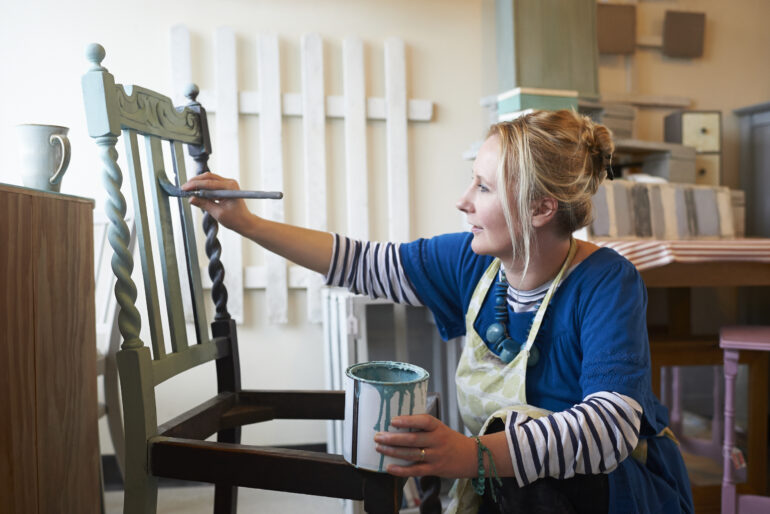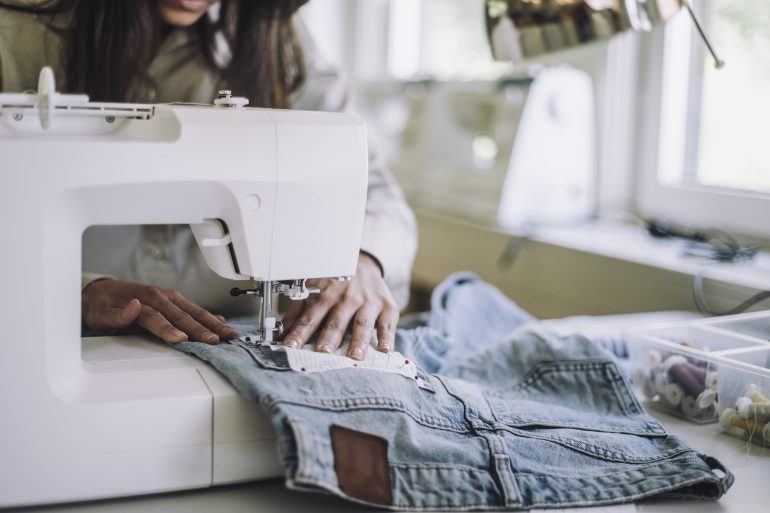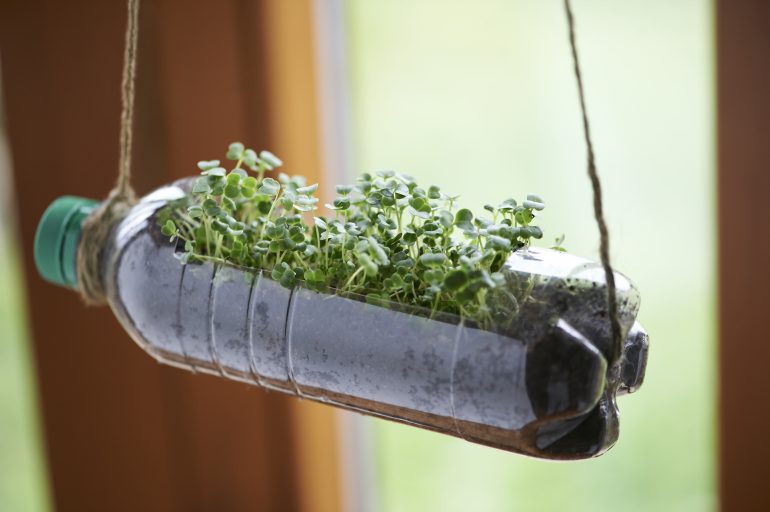In essence, upcycling, distinct from traditional recycling, involves taking used or discarded materials and products and giving them a new lease of life. Upcycling is an artful expression of both environmental consciousness and creative ingenuity.
One upcycling definition suggests that it’s the act of taking an item that is headed for landfill and transforming or repurposing it into something of equal or greater financial, artistic or environmental value. Another more simplistic definition is the process of making new furniture or objects out of old things.
So what does upcycle mean? At its heart, it’s a domain where creativity reigns supreme, and the results are often as surprising as they are delightful. This transformative approach doesn’t just give tangible objects a second chance, it also invites us to reimagine our relationship with the material world, signalling a future where sustainability and innovation go hand in hand.
Here, we’ll answer the question ‘what is upcycling’. We’ll look at upcycling vs. recycling and we’ll give you some great upcycling ideas!
A Short History of Upcycling

Upcycling (Credit: Dougal Waters via Getty Images)
Historically, while the term ‘upcycling’ is relatively modern – having gained traction in the late twentieth century – the practice itself goes back much further. Since the time of early humans, the idea of reusing objects and resources was borne out of necessity, when resources were scarce rather than a signal of early environmental consciousness.
During World War II, Britain’s Ministry of Information launched the famous Make Do & Mend campaign in 1943 in an effort to encourage people to upcycle and recycle clothes as well as giving them information on storage and cleaning. The following decade saw the evolution of the junk art movement, where artists would create art pieces from scrap metal, broken machines, timber off-cuts and other things considered as waste.
What Do You Do With a Broken Pot?
Many people would throw it away, but in Japan, it gives the upcycling definition a whole new meaning. Translated as ‘golden joinery’, the intricately beautiful art of kintsugi is the Japanese method of repairing broken pottery by accentuating the cracks. In this method, the cracks and breaks in pottery are mended using a lacquer mixed with powdered gold, silver, or platinum. Rather than hiding the imperfections, kintsugi highlights them, treating the breakage and repair as part of the history and beauty of an object, rather than something to be disguised. It resonates with the broader Japanese philosophy of wabi-sabi, which finds beauty in the flawed or imperfect. This might just be the best answer to the idea of ‘what does upcycle mean’ in its purest form, the idea of making something ultimately better and of higher value from an object which is seen as broken or obsolete.
What is Modern Upcycling?

Upcycling an old pair of jeans. (Credit: Maskot via Getty Images)
It’s believed that the word upcycling itself was first coined by a German businessman named Reiner Pilz who was interviewed in 1994 on the subject of a European waste directive.
‘Recycling? I call it downcycling. They smash bricks, they smash everything. What we need is upcycling, where old products are given more value, not less.’
While there were books discussing the idea of ‘what is upcycling’ in the late 1990s, William McDonough and Michael Braungart’s 2002 book Cradle to Cradle: Remaking the Way We Make Things more generally popularised the concept and brought it into mainstream consciousness.
The book goes into great depth answering the question what does upcycle mean, but in essence it discusses the idea of using waste as a resource, elevating its value rather than diminishing it, as is often the case in traditional recycling. It also advocates for a whole new way of thinking about design, manufacturing, and the lifecycle of products.
Though the practice of repurposing and reusing old materials in new ways has ancient roots, it was this modern framing and terminology that brought upcycling into wider recognition in the context of sustainable design and environmental awareness.
The Benefits of Upcycling vs Recycling

Upcycling a wooden stool. (Credit: Milko via Getty Images)
The importance of upcycling cannot be overstated. In an era confronting the realities of environmental degradation, climate change, and resource scarcity, upcycling offers an eco-friendly alternative that reduces landfill waste, conserves energy and reduces our carbon footprint, diminishes our ecological impact and minimises the extraction of natural resources.
By repurposing and revamping, we actively engage in sustainable consumerism, echoing the make do and mend mantra that harks back to earlier times.
So what is the difference between upcycle and recycle? Recycling and upcycling are both eco-friendly practices aimed at reducing waste and promoting sustainability, but they approach these goals from different angles.
Process & Purpose
Recycling involves breaking down waste materials and then processing them into new products. For example, recycled paper is usually broken down into pulp, cleaned, and then reconstituted into new paper products. Recycling aims to divert waste from landfills by reprocessing materials to create new products. Instead of breaking items down, upcycling usually involves creatively repurposing or transforming discarded products or materials into new items. The focus is not just on waste reduction but also on adding value. For instance, an old ladder might be upcycled into a unique bookshelf without significantly altering its original form.
Energy Consumption
Recycling typically requires energy, especially when materials are melted, refined, or reprocessed. For some materials, such as aluminium, recycling still uses considerably less energy compared to creating the product from raw materials. Upcycling generally consumes less energy because it focuses on reusing materials in their existing form. As upcycling is often done by hand or with minimal machinery, it usually has a lower carbon footprint compared to recycling.
End Products
Recycling produces items that are similar to the original or may degrade in quality after multiple recycling processes. For instance, recycled paper might not be as robust or bright as virgin paper, and plastic can degrade in quality after being recycled multiple times. The end products of upcycling projects are often unique, artistic, and value-added. Since the goal is to enhance or transform the original item, the results can be unexpected and innovative.
Scope
Recycling often involves large-scale operations, infrastructure, and systems like municipal collection services, specialised facilities, and machinery. Upcycling can be both a large-scale industry or a DIY project. Many artisans, crafters, and eco-conscious consumers upcycle items at home or in small workshops.
Broadly speaking, while both recycling and upcycling promote sustainability, the differences between upcycle and recycle are clear. Recycling revolves around reprocessing materials, and upcycling emphasises creative transformation. Together, they offer a multifaceted approach to managing waste and promoting a more sustainable future.
Fun Upcycling Ideas

Upcycled plastic bottle re used as a hanging planter to grow green seedlings. (Credit: Dougal Waters via Getty Images)
Almost anything can be upcycled. From turning a worn-out pair of jeans into a handbag to converting discarded wooden pallets into chic furniture, the possibilities are boundless.
Have you got an old chest of drawers at home or a wardrobe with the doors falling off their hinges? Imagine what they would look like with a coat of colourful paint, new or repaired doors and some funky new handles?
We’ve got some great upcycling ideas for you, including how to make wonderful wind chimes, cool DIY bookmark ideas, a great guide on what to make with empty plastic bottles and now the kids are back to school, what can you make with all those empty shoeboxes? This guide will help you out!
Transform an old suitcase into a retro-style coffee table, an old ladder can become a great trellis in your garden, old t-shirts and jumpers can be repurposed into cool cushions, and if you’ve got an old cheese grater you don’t use anymore, seal the base, turn it upside down and use it for your wooden spoons!
A Renaissance of Re-Use

Old wellington boots up cycled to be used as plant pots. (Credit: Pusteflower9024 via Getty Images)
As we navigate the complexities of our modern world, marked by rapid consumption and equally rapid discarding, upcycling emerges not just as a trend, but as a necessity. It urges us to reconsider our relationship with the materials around us, beckoning us to see potential where others might see waste. More than just an artistic endeavour, upcycling epitomises an evolving mindset that merges creativity with responsibility.












